Nestled high in Vietnam’s northern mountains, a rare botanical treasure thrives in the misty air. Shan Tuyet tea, with its distinctive white downy “snow” covering young leaves, represents centuries of Vietnamese tea culture and tradition. This ancient tea variety, grown on trees that have witnessed generations pass, delivers a remarkable drinking experience that captures the essence of its mountainous homeland. Join Phieu Travel as we explore the captivating world of Shan Tuyet tea, from its fascinating origins to its cultural significance and exceptional flavor profile that tea enthusiasts worldwide have come to cherish.
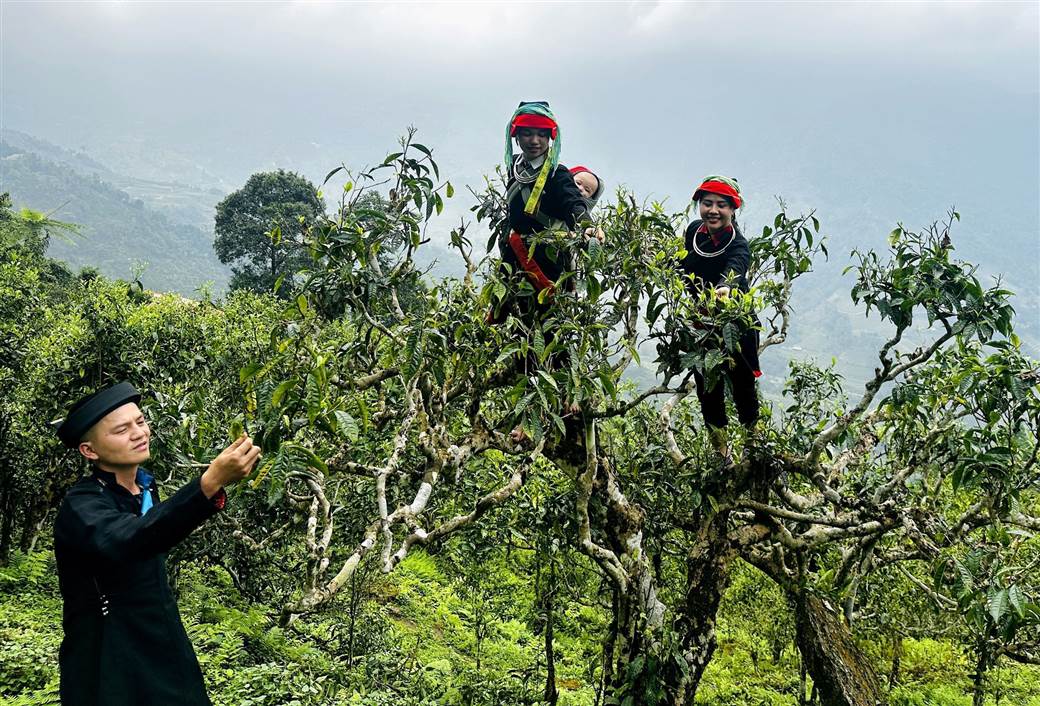
1. What Is Shan Tuyet Tea?
Shan Tuyet tea represents one of Vietnam’s most precious agricultural treasures, distinguished by its ancient origins and distinctive characteristics. The name itself reveals its unique nature: “Shan” references the indigenous tea variety, while “Tuyet” means “snow” in Vietnamese, describing the fine white fuzz that coats the young tea buds and leaves. This tea isn’t just another variety it’s a living artifact of Vietnam’s agricultural history and cultural heritage.
Unlike conventional tea bushes cultivated in plantations, Shan Tuyet grows on large, ancient trees that reach heights of 15-20 meters. These aren’t the neatly trimmed hedges you might picture when thinking of tea cultivation. Rather, they’re magnificent forest trees with thick trunks, sprawling branches, and deep root systems that have adapted to mountain environments over centuries.
1.1 Origin of the Name
The poetic name “Shan Tuyet” perfectly captures this tea’s most distinguishing visual characteristic. When you examine young Shan Tuyet buds and leaves up close, you’ll notice they’re covered with a delicate, silvery-white down that resembles a dusting of fresh mountain snow. This natural coating serves as protection for the young leaves against harsh mountain conditions, including temperature fluctuations, insects, and excessive sunlight.
Local ethnic minority communities have long recognized this distinctive feature, passing down stories about “snow tea” through generations. The name has become synonymous with quality and authenticity in Vietnamese tea culture. When tea lovers encounter genuine Shan Tuyet, this characteristic fuzz confirms they’re experiencing the real thing a tea shaped by both nature and tradition.
1.2 Ancient Tea Trees and “Snowy” Fuzz
The ancient Shan Tuyet trees stand as living monuments in Vietnam’s northern highlands. Many of these trees are several hundred years old, with some particularly venerable specimens estimated to be 300-800 years of age. Unlike modern tea cultivars bred for specific traits, these ancient trees represent an original, wild tea variety that has naturally adapted to its environment over centuries.
The distinctive “snowy” appearance comes from fine trichomes tiny hair-like structures that grow on the buds and young leaves. Beyond their visual appeal, these trichomes play crucial roles in the plant’s survival and the tea’s final character. They protect the young growth from harsh mountain conditions and contribute significantly to the tea’s flavor profile, adding subtle sweetness and complexity that tea enthusiasts prize.
What makes Shan Tuyet truly special is how these ancient trees interact with their environment. Their deep roots absorb minerals from virgin mountain soil, while the misty climate, altitude, and natural biodiversity all influence the leaves’ development. This ecological relationship creates a tea that carries the essence of its homeland a genuine taste of Vietnam’s northern mountains.
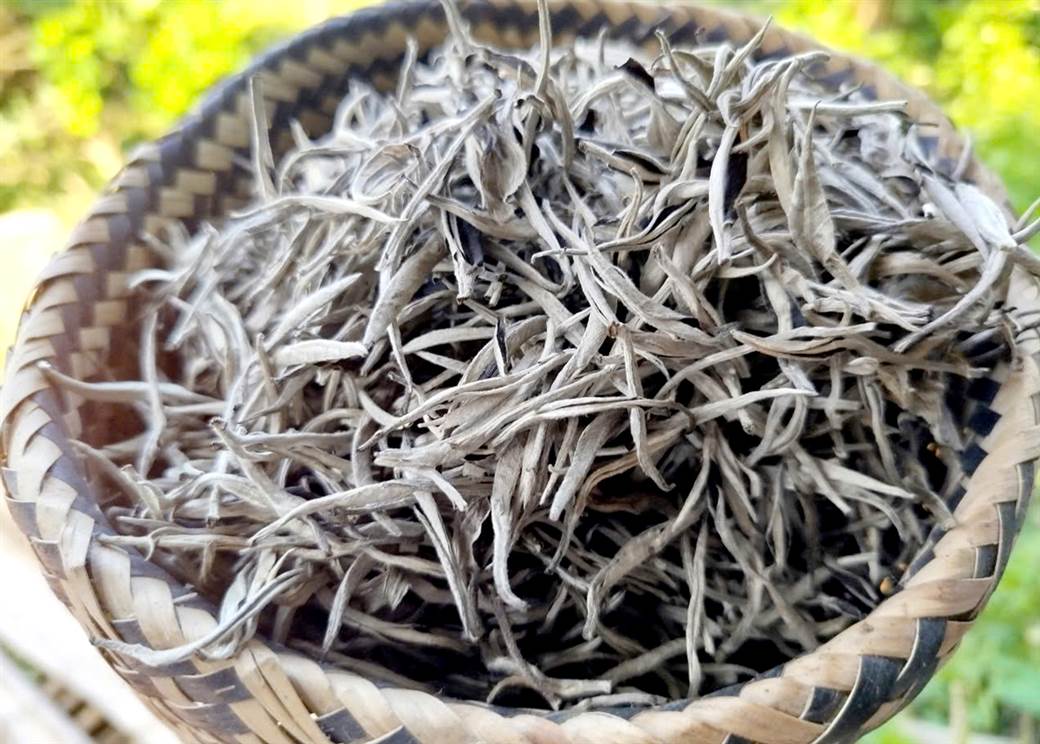
2. Where Is Shan Tuyet Tea Grown?
Shan Tuyet tea thrives in Vietnam’s northern highlands, where specific geographical and climatic conditions create the perfect environment for these ancient trees. The ideal habitat combines high elevation (typically 1,000-2,800 meters above sea level), regular mountain mist, cool temperatures, and virgin soil rich in minerals. These conditions aren’t found everywhere, which explains why genuine Shan Tuyet remains relatively rare despite growing demand.
The northern mountainous provinces have become synonymous with quality Shan Tuyet production. Each region imparts subtle differences to the tea’s character, creating distinct terroirs that tea connoisseurs can identify through careful tasting. While commercial tea plantations exist in many parts of Vietnam, authentic ancient tree Shan Tuyet remains primarily concentrated in these traditional growing areas.
At Phieu Travel, we’ve explored these remote tea regions extensively, connecting with local producers who maintain centuries-old harvesting traditions. The journey to these tea forests often requires traveling winding mountain roads and hiking steep paths but the rewards of experiencing these ancient trees in their natural habitat make every effort worthwhile.
2.1 Key Regions (Ha Giang, Suoi Giang, Lao Cai)
Ha Giang Province stands as perhaps the most celebrated Shan Tuyet growing region. Within its borders, areas like Tay Con Linh mountain range host ancient tea forests where trees estimated at 300+ years still produce exceptional leaves. The province’s limestone-rich soil, regular cloud cover, and perfect elevation create ideal growing conditions. Local H’mong and Dao ethnic communities have harvested these trees for generations, maintaining traditional processing methods that preserve the tea’s authentic character.
Suoi Giang in Yen Bai Province offers another important Shan Tuyet sanctuary. This remote area is home to what some experts consider Vietnam’s oldest tea trees, with certain specimens reportedly exceeding 800 years of age. The region’s H’mong communities regard these ancient trees as spiritual treasures, following careful harvesting protocols passed down through generations. Suoi Giang’s unique microclimate, characterized by cool temperatures and frequent mist, produces a Shan Tuyet variant with particularly pronounced sweetness.
Lao Cai Province, especially areas near Sapa and Ta Xua, completes the triumvirate of premier Shan Tuyet regions. Here, ancient tea forests grow alongside other highland crops in a harmonious agricultural system maintained by ethnic minority farmers. The slightly different growing conditions including higher average rainfall create Shan Tuyet with distinctive aromatic qualities that set it apart from neighboring regions.
2.2 Impact of Terroir
The concept of terroir how geography, climate, and human factors influence an agricultural product applies beautifully to Shan Tuyet tea. Each growing region leaves its signature on the final product, creating subtle variations that experienced tea drinkers can detect. This isn’t simply marketing language; it’s a genuine reflection of how deeply these ancient trees connect with their environment.
Altitude plays a crucial role in developing Shan Tuyet’s character. Trees growing above 1,800 meters typically produce leaves with higher concentrations of certain flavor compounds and antioxidants. The slower growth at these elevations allows more time for complex compounds to develop within the leaves. Meanwhile, the significant day-night temperature fluctuations common at high elevations stress the plants in ways that enhance flavor development.
Soil composition varies significantly across northern Vietnam’s mountains, affecting mineral uptake and subsequently altering the tea’s flavor profile. Tay Con Linh’s limestone-rich soils impart a distinct mineral quality, while the volcanic soils in parts of Suoi Giang contribute to a smoother mouthfeel. When you taste authentic Shan Tuyet, you’re experiencing not just the tea plant but the entire mountain ecosystem that nurtured it a true expression of Vietnamese terroir.
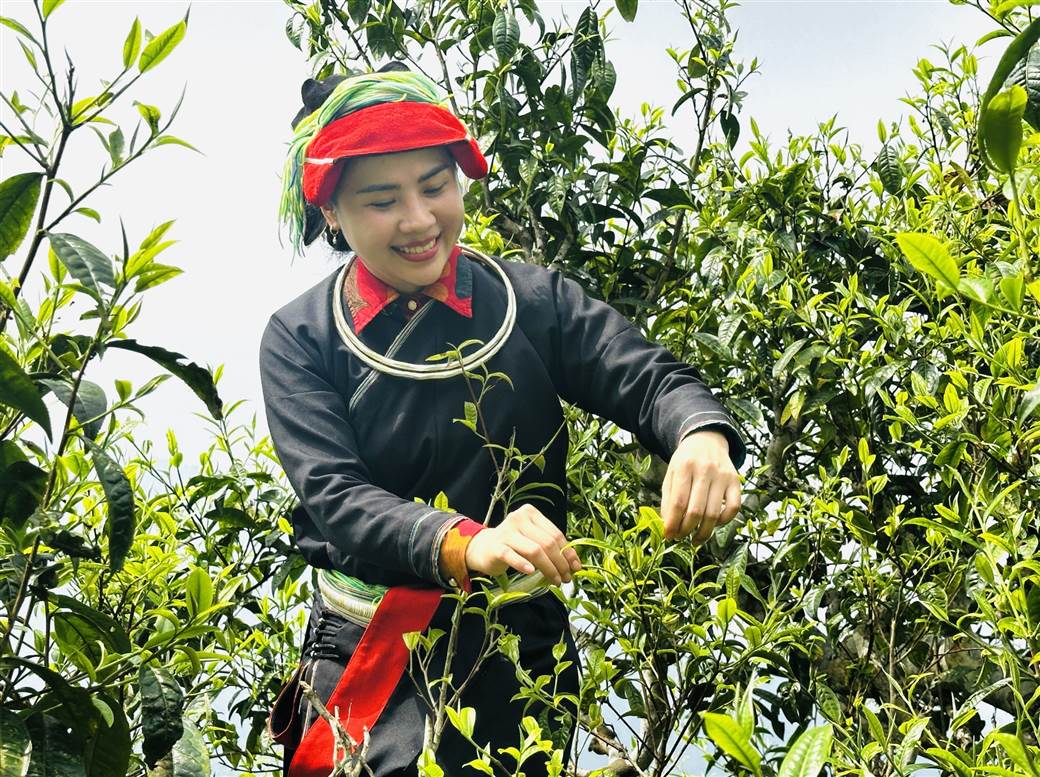
3. How Is Shan Tuyet Tea Harvested and Processed?
The journey from tree to teacup involves carefully preserved traditions that honor both the tea and those who tend it. Harvesting Shan Tuyet requires patience, skill, and intimate knowledge of the trees. Unlike commercial tea operations where efficiency drives harvesting decisions, authentic Shan Tuyet production follows natural rhythms and quality-focused practices that haven’t changed substantially for generations.
Harvesting typically occurs during specific seasonal windows when the trees produce their finest leaves. Spring harvest (March-April) yields leaves with delicate flavors highly prized by connoisseurs. Summer harvests (May-August) produce more robust flavor profiles, while autumn collections (September-October) offer a balance between the two. Winter typically marks a rest period for the trees, though some regions may have limited winter harvests.
Once harvested, processing begins immediately to preserve the leaves’ qualities. While modern tea factories exist in Vietnam, traditional Shan Tuyet processing often happens in village settings using methods passed down through generations. This connection between traditional knowledge and final product remains essential to authentic Shan Tuyet tea.
3.1 Traditions of Local Ethnic Minorities
Ethnic minority communities particularly the H’mong, Dao, and Tay peoples have maintained Vietnam’s ancient tea forests for centuries. Their relationship with these trees transcends simple agriculture; it represents a profound cultural connection. Many families can trace their tea harvesting traditions back numerous generations, with specific trees sometimes tended by the same family line for hundreds of years.
Harvesting practices reflect this deep relationship. Skilled pickers, often women from ethnic minority communities, carefully select only the most perfect buds and young leaves. They navigate the ancient trees with remarkable agility, reaching high branches where the finest leaves grow. Traditional beliefs inform their approach many harvesters avoid picking during certain lunar phases or after rainfall, believing these factors affect the tea’s energy and quality.
Beyond technical skill, these communities contribute invaluable cultural context to Shan Tuyet production. Tea preparation ceremonies, folk songs about tea cultivation, and traditional medicinal applications all form part of their tea heritage. At Phieu Travel, we’ve had the privilege of learning these traditions directly from community elders during our northern Vietnam expeditions experiences that deepen our appreciation for this remarkable tea.
3.2 Processing Methods by Tea Type
The processing path determines which type of Shan Tuyet tea emerges from the freshly harvested leaves. Green Shan Tuyet undergoes the simplest processing: after picking, leaves are quickly heated (traditionally in woks over wood fires) to halt oxidation. This “fixing” step preserves the leaves’ natural compounds and green character. Following this, the leaves are shaped (often by hand) and dried thoroughly to remove moisture and stabilize the tea.
White Shan Tuyet follows an even more minimalist approach. After careful harvesting of primarily buds and very young leaves, the material is simply allowed to wither naturally with minimal handling. This gentle process preserves the highest levels of natural antioxidants and results in a delicate, sweet flavor profile. The characteristic white fuzz remains visible on the finished tea, creating a beautiful visual presentation.
Black Shan Tuyet (known locally as “red tea”) undergoes full oxidation. After withering, the leaves are rolled to break cell walls and expose enzymes to oxygen. This initiates oxidation, transforming the leaf chemistry and developing deeper flavors. The process continues until the leaves turn dark, after which they’re dried to lock in the developed characteristics. The result offers rich, smooth flavors with natural sweetness and complex notes of honey, malt, and dried fruit.
Yellow Shan Tuyet represents a rare traditional processing method unique to certain regions. It follows a path similar to green tea but includes a distinctive “yellowing” step where slightly dampened leaves undergo a brief controlled heaping under specific cloth coverings. This creates unique flavor compounds not found in other tea types, resulting in a smooth character with diminished astringency and distinctive aromatics.
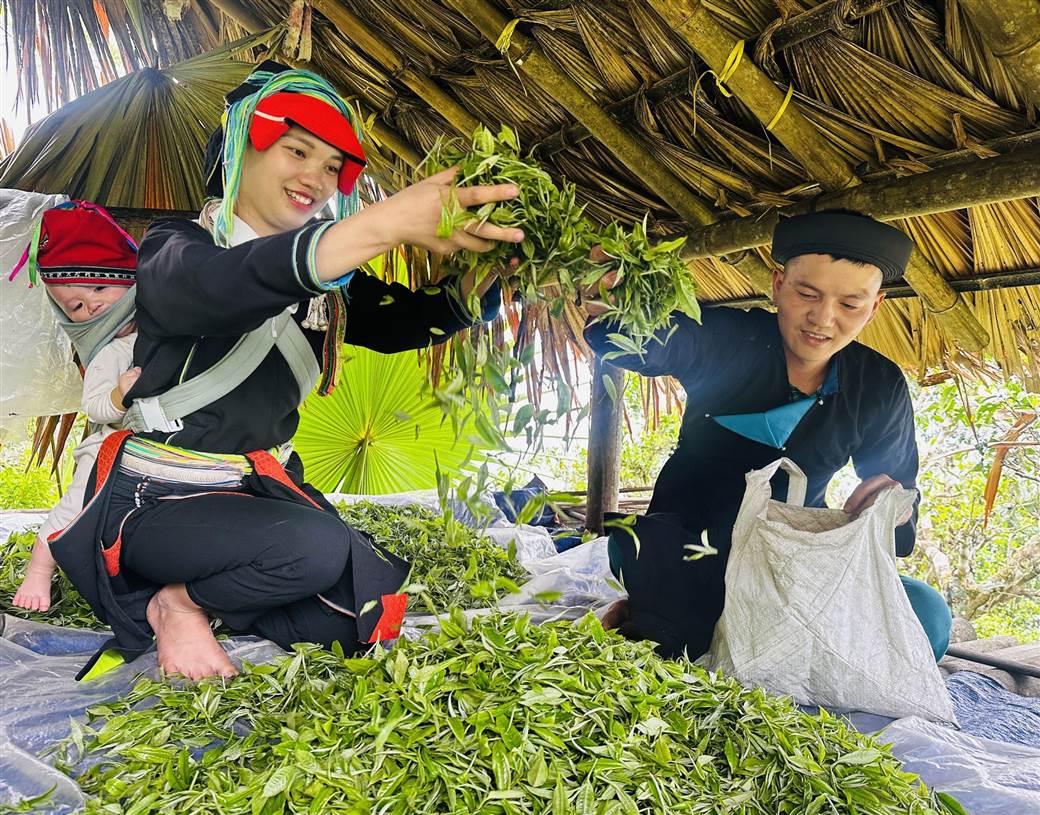
4. Types, Flavor Profiles, and Brewing Tips
Shan Tuyet tea offers remarkable diversity despite coming from the same plant species. Different processing methods, harvest seasons, and growing regions create distinct variations that appeal to different palates. Understanding these differences helps you select the perfect Shan Tuyet for your taste preferences and brewing situation.
Each type presents a unique sensory experience, from the fresh vegetal notes of green varieties to the honey-like sweetness of fully oxidized black versions. The flavor complexity stems partly from the trees’ ancient genetics and deep root systems, which access mineral-rich soil layers unavailable to shallow-rooted tea bushes. This creates distinctive taste characteristics that set Shan Tuyet apart from commercially grown teas.
When brewing Shan Tuyet, remember you’re working with a tea that developed its character slowly over decades or centuries so patience during preparation rewards you with the fullest expression of its qualities. At Phieu Travel, we encourage visitors to experience different Shan Tuyet varieties during their northern Vietnam journeys, often arranging tastings with local producers who demonstrate traditional brewing methods.
4.1 Green vs. White vs. Black vs. Yellow Shan Tuyet
Green Shan Tuyet delivers a vibrant cup with remarkable complexity despite its minimal processing. The flavor profile typically includes fresh vegetal notes reminiscent of steamed greens or sweet grass, complemented by distinct nutty undertones. Many tasters detect a pleasant mineral quality that reflects the tea’s mountain origins. The mouthfeel tends toward medium-bodied with a clean finish and pleasant lingering sweetness that distinguishes it from other green teas.
White Shan Tuyet represents the most delicate expression of this tea’s character. Its flavor profile centers on subtle sweetness with gentle floral notes and hints of fresh hay. The minimal processing preserves high levels of natural compounds, creating a sophisticated complexity that reveals itself through multiple infusions. The mouthfeel tends toward silky lightness with no astringency, making it accessible even to those who typically find tea too strong.
Black Shan Tuyet transforms the leaves’ character through oxidation, developing rich depth while maintaining the tea’s fundamental mountain character. Flavor notes typically include honey, malt, cacao, and dark fruits, with pleasant woody undertones. The natural sweetness remains pronounced even without added sweeteners. The full-bodied mouthfeel offers satisfying richness without the astringency sometimes found in other black teas.
Yellow Shan Tuyet presents a fascinating middle ground between green and black varieties. Its unique processing creates a smooth, rounded flavor profile with diminished grassiness compared to green tea but without the deeper oxidized notes of black tea. Tasters often describe notes of chestnuts, sweet corn, and light honey. The mouthfeel tends toward medium-bodied with exceptional smoothness and minimal astringency.
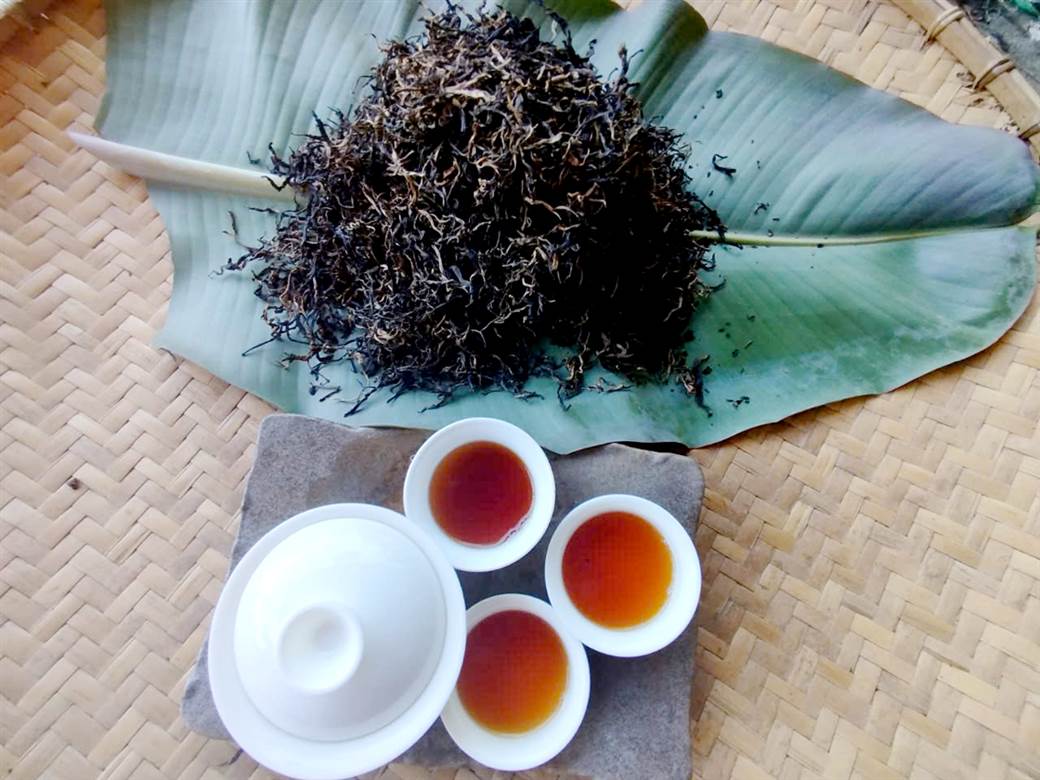
4.2 Step-by-Step Brewing Guide
Brewing Shan Tuyet tea properly unveils its full potential. While different varieties benefit from slightly different approaches, these general guidelines will help you achieve excellent results with any authentic Shan Tuyet:
1. Water quality and temperature: Start with fresh, filtered water without strong mineral content. For green and white varieties, heat water to 175-185°F (80-85°C); for black varieties, use water at 195-205°F (90-96°C); for yellow varieties, aim for 185-195°F (85-90°C). Using water that’s too hot, especially for green and white varieties, can extract unwanted bitterness.
2. Tea quantity: Use approximately 3-4 grams (about one tablespoon) of loose leaf Shan Tuyet per 8 ounces (240ml) of water. Adjust slightly based on personal preference more tea creates stronger flavor, while less produces a lighter cup.
3. Vessel selection: Traditional clay teapots work beautifully with Shan Tuyet, though porcelain gaiwans or glass teapots also perform well. Avoid metal infusers when possible, as they can affect the tea’s delicate flavors.
4. Initial rinse: For older or more compressed teas, consider a quick 5-second “rinse” with hot water to awaken the leaves. Simply discard this water before proceeding with the actual infusion.
5. Steeping time: For the first infusion, steep green varieties for 1-2 minutes, white for 2-3 minutes, black for 3-4 minutes, and yellow for 2-3 minutes. Subsequent infusions should increase gradually in duration.
6. Multiple infusions: Quality Shan Tuyet can typically support 3-5 good infusions, each revealing different aspects of the tea’s character. Don’t discard the leaves after a single steeping you’ll miss much of what makes this tea special.
Remember that these guidelines serve as starting points rather than rigid rules. Feel free to adjust based on your preferences and the specific Shan Tuyet variety you’re brewing. The journey of discovering your perfect brewing method is part of the pleasure of exploring this remarkable tea.
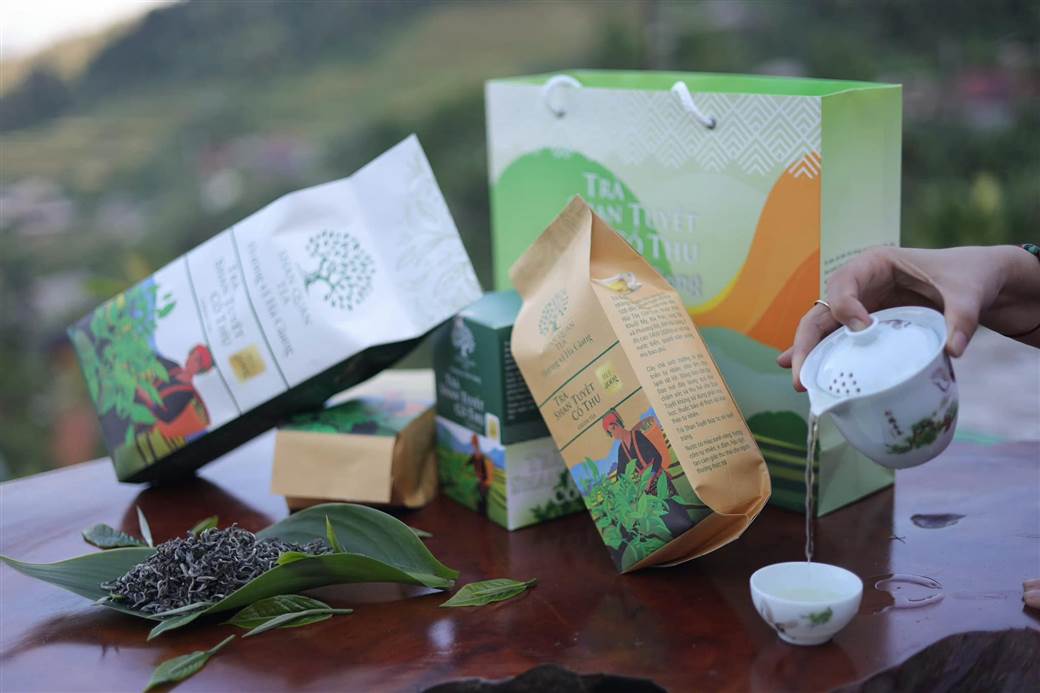
Men Men of Ha Giang: Discover the Hmong’s traditional soul food
5. Health Benefits and Nutritional Properties
Shan Tuyet tea has been valued for centuries not only for its exquisite flavor but also for its wellness properties. Traditional Vietnamese medicine has long recognized this tea as beneficial for overall health, using it to address various ailments and promote longevity. Modern scientific research increasingly supports many of these traditional claims, identifying specific compounds that contribute to Shan Tuyet’s health-promoting potential.
Like other true teas (from Camellia sinensis), Shan Tuyet contains various bioactive compounds including catechins, flavonoids, amino acids, and essential minerals. However, the ancient tree varieties often contain higher concentrations of certain beneficial compounds compared to conventional tea cultivars. The trees’ deep root systems access nutrient-rich soil layers, while their natural growing conditions without chemical inputs preserve the plants’ natural protective compounds.
At Phieu Travel, we’ve witnessed how local communities integrate Shan Tuyet into their wellness routines, often consuming it daily as part of a balanced approach to health. While no tea should be viewed as a miracle cure, the growing body of research supporting tea’s health benefits makes Shan Tuyet an excellent addition to a wellness-oriented lifestyle.
5.1 Antioxidants (EGCG Content)
Shan Tuyet tea contains impressive levels of catechins powerful antioxidant compounds that help combat oxidative stress in the body. The most significant of these is epigallocatechin gallate (EGCG), which has been extensively studied for its potential health benefits. Research suggests EGCG may help neutralize harmful free radicals, reduce inflammation, and support cellular health.
The ancient Shan Tuyet trees typically produce leaves with higher EGCG content than conventional tea bushes. This likely results from the trees’ natural defense mechanisms developed over centuries of adaptation to their environment. The minimal processing of green and white Shan Tuyet varieties particularly preserves these beneficial compounds, making them excellent choices for those seeking maximum antioxidant intake.
Beyond EGCG, Shan Tuyet contains a diverse profile of other polyphenols that work synergistically to support health. These include other catechins, flavonols like quercetin, and theaflavins (especially in oxidized varieties). This complex antioxidant profile may offer more comprehensive benefits than isolated compounds, highlighting the value of consuming whole, natural tea rather than supplements.
5.2 Scientific Studies and Wellness Claims
Research into tea’s health benefits continues to expand, with studies suggesting various potential advantages to regular tea consumption. Several studies have examined green tea’s potential to support cardiovascular health by helping maintain healthy cholesterol levels and supporting normal blood pressure. While most research has focused on tea generally rather than Shan Tuyet specifically, the fundamental compounds responsible for these effects are present in this ancient variety.
The L-theanine content in Shan Tuyet may contribute to its reported cognitive benefits. This amino acid, relatively rare outside of tea, has been studied for its ability to promote relaxation without drowsiness and support mental clarity. The combination of L-theanine with tea’s moderate caffeine content creates what many researchers describe as “mindful alertness” a balanced state of calm awareness.
Traditional Vietnamese medicine attributes additional properties to Shan Tuyet, including supporting digestive health, enhancing respiratory function, and promoting longevity. While scientific validation of these specific claims remains limited, emerging research continues to identify mechanisms that may explain these traditional observations. As with any wellness approach, individuals should consult healthcare providers when considering tea as part of their health regimen, especially if taking medications or managing specific health conditions.
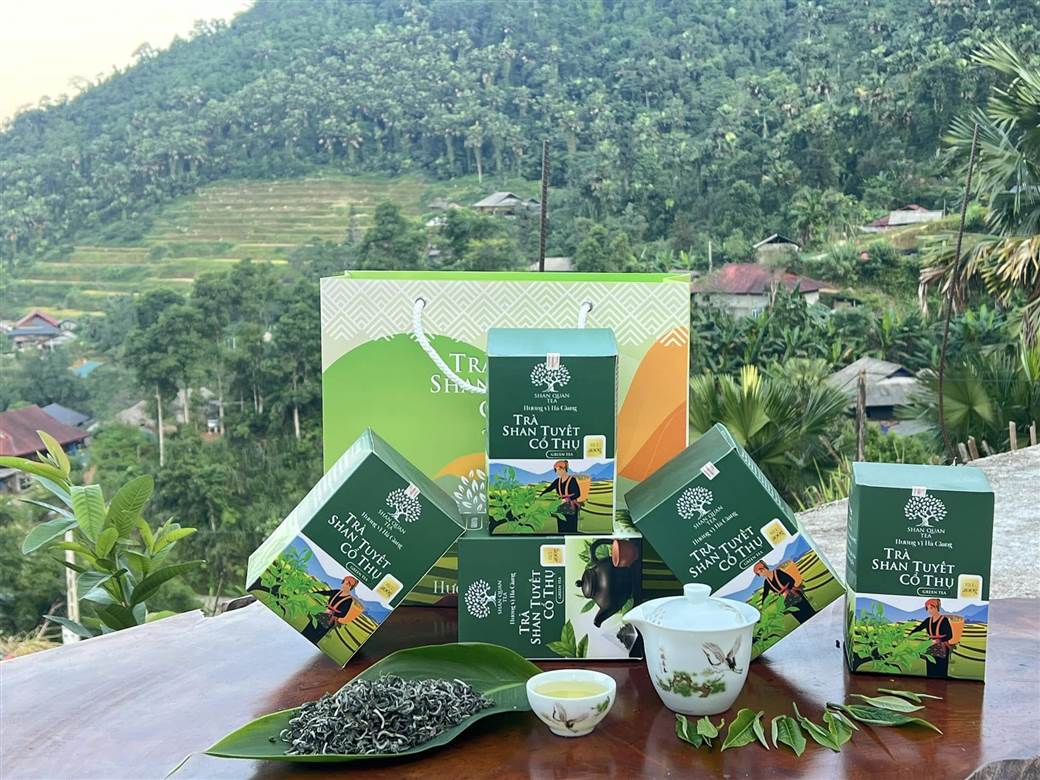
6. Cultural Significance and Economic Impact
Shan Tuyet tea represents far more than a beverage in Vietnamese culture it embodies centuries of tradition, spiritual practices, and community bonds. The ancient tea trees have witnessed generations of human history, becoming living connections to ancestral knowledge and cultural heritage. Understanding this cultural dimension adds depth to your appreciation of Shan Tuyet, transforming each cup into a connection with Vietnam’s rich cultural tapestry.
For ethnic minority communities in northern Vietnam, these ancient tea forests represent both cultural heritage and economic opportunity. As interest in authentic Shan Tuyet grows domestically and internationally, these communities face both challenges and possibilities. Balancing traditional practices with economic development remains an ongoing conversation among producers, government agencies, and community leaders.
At Phieu Travel, we’ve observed how sustainable tea tourism can support both cultural preservation and economic empowerment. By bringing travelers to experience authentic Shan Tuyet in its native environment, we help create markets for traditionally produced tea while supporting communities who maintain ancient harvesting traditions.
6.1 Shan Tuyet in Vietnamese Rituals
Tea ceremonies have deep roots in Vietnamese culture, with Shan Tuyet often holding a place of honor in traditional rituals. For many ethnic minority communities, tea serves as a medium for connecting with ancestors, welcoming guests, and marking important life transitions. The offering of tea shows respect and hospitality, while the shared experience of drinking creates bonds between participants.
Wedding ceremonies in many northern communities include specific tea rituals where Shan Tuyet plays a central role. The bride traditionally prepares and serves tea to the groom’s family, demonstrating both skill and respect. The quality of the tea and the grace of its presentation have traditionally been considered reflections of the bride’s character and family background.
Spiritual practices often incorporate Shan Tuyet as an offering to ancestors or local deities. Many communities maintain small shrines near particularly ancient tea trees, acknowledging their spiritual significance. During harvest seasons, rituals may be performed to show gratitude for the trees’ bounty and ensure continued protection of the tea forests.
6.2 Sustainability and Community Trade
The growing international interest in authentic Shan Tuyet creates both opportunities and challenges for sustainability. As demand increases, maintaining traditional harvesting practices becomes economically viable for local communities. However, this same demand can sometimes lead to over-harvesting or attempts to expand production in ways that threaten the tea’s authenticity and environmental balance.
Several community-based initiatives now focus on sustainable Shan Tuyet production. These programs emphasize organic growing methods, fair compensation for harvesters, and protecting ancient trees. Some communities have established cooperative structures that allow small-scale producers to access larger markets while maintaining traditional quality standards.
Certification programs for authentic ancient tree Shan Tuyet have emerged to help consumers identify responsibly produced tea. These systems verify factors like tree age, growing conditions, harvesting methods, and fair compensation practices. By supporting certified producers, tea enthusiasts contribute to preserving both the cultural heritage and environmental sustainability of these remarkable tea forests.
The economic impact of Shan Tuyet extends beyond direct tea sales to include tourism opportunities. Tea-focused tours bring visitors to remote mountain communities, creating additional income streams through homestays, guided experiences, and cultural demonstrations. This diversification helps stabilize local economies while incentivizing the preservation of both tea forests and cultural traditions.
7. Experiencing Shan Tuyet: Where to Find and How to Choose
For tea enthusiasts eager to experience authentic Shan Tuyet, several pathways exist to discover this remarkable brew. Finding genuine ancient-tree Shan Tuyet requires some knowledge and discernment, as the growing popularity has unfortunately led to some mislabeling and quality variations in the market. However, with the right approach, you can access truly exceptional examples of this Vietnamese treasure.
The most immersive option involves traveling to the source regions with experienced guides. Visiting Ha Giang, Suoi Giang, or other key growing areas allows you to witness the ancient trees firsthand, meet the communities who tend them, and taste freshly processed tea. This direct connection to the source provides unparalleled insight into what makes Shan Tuyet special.
For those unable to travel to northern Vietnam immediately, specialty tea retailers increasingly offer authenticated Shan Tuyet. Look for vendors who provide detailed information about specific origins, processing methods, and harvest dates. Reputable sellers will typically share the stories of the producers and communities behind their teas.
7.1 Quality Indicators and Pricing Guide
When selecting Shan Tuyet tea, several quality indicators can guide your choices. Visual appearance offers important clues look for whole, intact leaves rather than broken fragments. In unprocessed or lightly processed varieties, the characteristic white down should be visible on buds and young leaves. The dry leaves should have a fresh, clean aroma without mustiness or off-notes. Origin specificity often correlates with quality. Teas labeled simply as “Vietnamese tea” without details about specific growing regions likely come from commercial plantations rather than ancient tree forests. Look for precise location information such as “Tay Con Linh ancient tree Shan Tuyet” or “Suoi Giang old-growth tea,” which suggests authenticity and traceability. Price can also indicate quality, though with important caveats. Genuine ancient tree Shan Tuyet typically costs more than commercial tea varieties due to limited production, hand-processing, and the special character of the leaves.
| Shan Tuyet Tea Type | Average Price (USD/kg) | Flavor Profile |
| White Shan Tuyet | $60 – $140+ | Delicate, sweet with floral notes and a smooth finish. |
| Green Shan Tuyet | $35 – $80 | Fresh, vegetal, with nutty undertones and mineral notes. |
| Black Shan Tuyet | $30 – $75 | Rich, full-bodied with notes of honey, malt, and dark fruit. |
| Yellow Shan Tuyet | $50 – $100 | Smooth, mellow, with notes of corn and light honey. |
Important notes on pricing:
- Pricing Varies: The prices listed are approximate and can fluctuate based on the specific origin (e.g., tea from the ancient trees of Tay Con Linh Peak will be more expensive), harvest season, and processing method.
- Harvest Season Impact: Spring harvest teas (March-April) generally command the highest prices due to superior quality and flavor.
- Authenticity is Key: High prices don’t always guarantee quality. It’s crucial to purchase from reputable sellers who provide clear information about the tea’s origin to avoid counterfeit products.
7.2 Tea Tourism with Phieu Travel
Experiencing Shan Tuyet in its native environment offers the most complete understanding of this remarkable tea. Phieu Travel specializes in crafting immersive journeys to northern Vietnam’s tea regions, connecting travelers with authentic experiences beyond typical tourist routes. Our tea-focused itineraries include visits to ancient tea forests, hands-on processing workshops with local producers, and guided tastings that highlight regional variations.
These journeys typically include homestays in ethnic minority villages where tea traditions remain alive. Guests participate in daily activities alongside host families, learning traditional harvesting and processing techniques passed down through generations. These personal connections create meaningful cultural exchange while supporting communities who maintain Vietnam’s tea heritage.
Beyond tea-specific activities, these expeditions incorporate broader cultural experiences that provide context for understanding Shan Tuyet’s significance. Local markets, craft villages, community festivals, and stunning mountain landscapes all form part of the comprehensive northern Vietnam experience. Guests return home with not just exceptional tea but also the stories, connections, and memories that enrich each future cup.
For those planning a northern Vietnam journey, Phieu Travel offers both established tea-focused itineraries and custom experiences tailored to specific interests. Whether you’re a serious tea connoisseur or simply curious about authentic cultural experiences, our team can design a journey that connects you meaningfully with Vietnam’s ancient tea traditions.
8. Preserving a Living Heritage
Shan Tuyet tea represents a living bridge between Vietnam’s past and future ancient trees nurtured by traditional knowledge, now gaining renewed appreciation in contemporary culture. These remarkable trees and the communities who tend them maintain practices developed over centuries, creating a tea that embodies both natural wonder and human heritage. As interest in authentic Shan Tuyet grows, thoughtful approaches to sustainability become increasingly important.
The ancient tea forests face various challenges, from climate change impacts to development pressures. Yet hopeful signs emerge as younger generations within ethnic minority communities show renewed interest in maintaining tea traditions. Innovative approaches combining traditional knowledge with modern sustainability practices suggest paths forward that honor both cultural heritage and environmental stewardship.
For tea enthusiasts worldwide, authentic Shan Tuyet offers a rare opportunity to experience a truly distinctive expression of terroir. Beyond its complex flavors and potential health benefits, each cup connects drinkers to centuries of Vietnamese tea culture and the remarkable mountain landscapes that shape it. This deeper appreciation transforms tea drinking from simple refreshment into a meaningful cultural connection.
At Phieutravel.com, we remain committed to supporting responsible Shan Tuyet production through our northern Vietnam journeys. By connecting travelers directly with tea-producing communities, we help create sustainable markets for traditionally produced tea while offering visitors authentic cultural experiences. We invite you to join us in exploring the remarkable world of Shan Tuyet tea whether through travel or simply by seeking out and appreciating this extraordinary Vietnamese treasure in your daily tea ritual.
Read more:
- Conquer Tay Con Linh Peak – Ha Giang’s Highest Mountain 2025
- La Chi People Vietnam – History, Culture, Traditions & Villages in Ha Giang
- Thang Co – The H’Mong People’s 200-Year-Old Exotic Stew

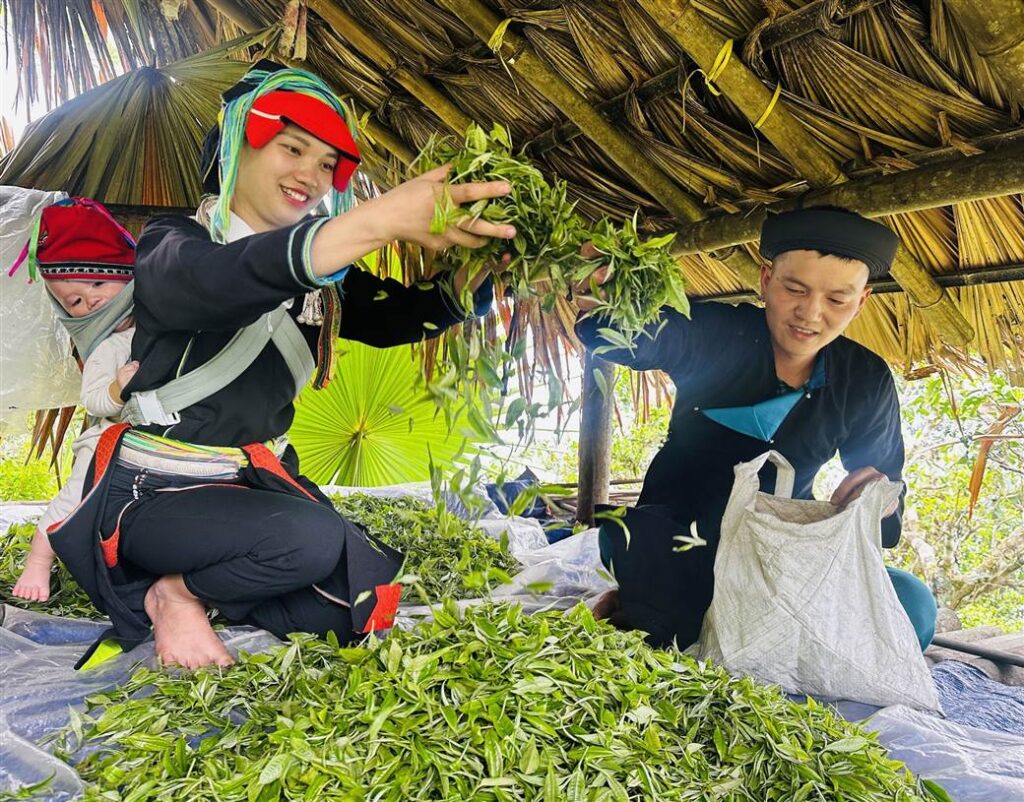
You Might Also Like
Ha Giang Weather in September: Complete Guide for Travelers
Exploring the magnificent Ha Giang Loop in September offers travelers a perfect balance of favorable[...]
Quan Ba Twin Mountains: Ha Giang’s Iconic Fairy Hills and Complete Travel Guide
The mystical Quan Ba Twin Mountains rise from the emerald valleys of Ha Giang like[...]
Vuong family mansion: the architectural marvel and cultural legacy of Ha Giang
Deep in Vietnam’s northern highlands, where mist-shrouded mountains meet terraced rice fields, stands a testament[...]
Ha Giang Loop Safety Tips: How to Ride Securely in Vietnam’s Northern Mountains
The Ha Giang Loop, with its winding mountain roads and breathtaking landscapes, offers one of[...]
The Ultimate Guide to the M-Shaped Curve on Ha Giang Loop
Vietnam’s remote northern province of Ha Giang hides a natural wonder that has captivated adventurous[...]
Most Beautiful Places to Visit in Vietnam: Essential Destinations and Insider Tips
Vietnam captivates travelers with its stunning landscapes, rich cultural heritage, and warm hospitality. From mist-shrouded[...]
Beyond the Beaten Path: Discovering Ha Giang Province in Northeast Vietnam
Ha Giang Province in Northeast Vietnam stands as one of the country’s last frontiers for[...]
Rainy season in Ha Giang: what to expect, when to go, and travel tips
Vietnam’s northern frontier reveals a different face during the rainy season, transforming Ha Giang’s limestone[...]